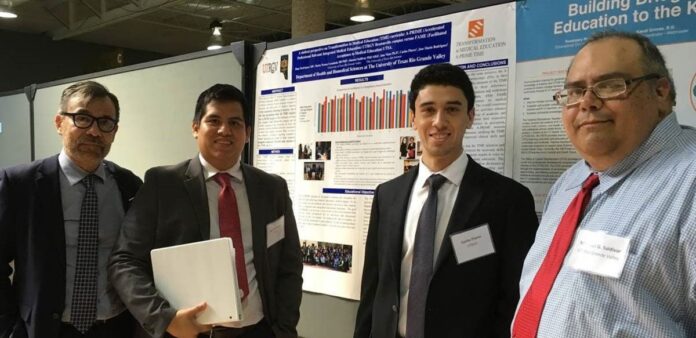BY Vicky Brito
BROWNSVILLE – Four groups from The University of Texas Rio Grande Valley’s Associated Professional, Relevant, Integrated Medical Education (A-PRIME) Transformation in Medical Education (TIME) students presented posters recently at the Innovations in Medical Education Conference, sponsored annually by the UT System’s six health science campuses.
The Innovations conference, held Feb 18-19 at the Common’s Learning Center on the J.J. Pickle Research Campus in Austin, includes nationally recognized speakers and local participants in the medical field.
Presenting from UTRGV were:
· Maria Abraham, Chelsey Abraham and Delilah Wahid – “Relationship between Academic Performance and Student Classroom Setting.”
· Carlos Flores and Jose Mario Rodriguez – “A student perspective on TIME curricula: A-PRIME vs. FAME (Facilitated Acceptance to Medical Education).”
· Imran Murtuza, Gonzalo Cedillo, Hector Filizola, Arvind Manojkumar and Albert Vasquez – “Selective Attention and Test Taking Approaches on the MCAT.”
· Florentino Saenz, Samantha Rocha, Alexis Villafranca and Deeksha Posani – “The Relationship between Stress Relief and Academic Performance.”
THE GROUPS
Maria Abraham serves as leader of her team, and their “Relationship between Academic Performance and Student Classroom Setting” poster addressed the differences in academic performance between students who had a technology-based education rather than those who had a “traditional” in-classroom education.
Dr. Maria Theresa Castañeda, lecturer in Health and Biomedical Sciences, had the idea for the research. The team tested two different groups of biomed students – traditional and tech-based. The groups were given the same final exam, and the results were compared.
Abraham said she was excited to be able to participate in the Innovations Conference.
“It was our first time going to something like that. We met many physicians and we were able to network with them,” she said.
The next step in their research will be to follow up with the tech-based students to see how they have improved and assimilated with their program.
Carlos Flores, serves as team leader and with his group did a comparison of UTRGV’s A-PRIME TIME and UT San Antonio’s Facilitated Acceptance into Medical Education (FAME) program. Both of these programs are part of the TIME initiative.
The group analyzed how the coordinating cohorts are developing their academic routines and evaluating the different curriculums.
Flores, who was presenting at an Innovations in Medical Education Conference for the second time, said he had always been curious about the differences in the two TIME initiatives.
“Attending the Innovations Conference was a really good opportunity to get my feet wet, in terms of knowing how medical education works and seeing it from a different perspective,” Flores said.
He will be graduating in May; his team partner, Jose Mario Rodriguez, graduated in December. Their research now will be continued by students who are part of the second biomed cohort.
Imram Murtuza serves as leader of the group that worked on “Selective Attention and Test Taking Approaches on the Medical College Admissions Test.” Known as the MCAT, the test is a critical part of the selection process for medical school.
“This poster is just to see different test-taking strategies toward the MCAT,” said Murtuza, whose group is part of the second cohort of biomed. “We’re going to be taking the MCAT pretty soon, and we got to thinking of strategies for taking the MCAT.”
Their different approaches to the test taking process included reading all passages, then doing the questions, reading the questions first the passages or taking it straight from beginning to end.
The biomedical students in Brownsville took the sample MCAT, which contained three passages with three questions for each passage.
“MCAT has been on everyone’s mind, we spent a semester brainstorming and coming up with a proposal,” Murtuza said.
This group was among the youngest of groups to attend the Innovations Conference.
“We got to learn a lot from the conference from all the various medical school and graduate schools that were present there,” Murtuza said.
The group got ideas from other conference participants on how to further expand their research to expand their sample to more participants.
The poster for Florentino Saenz’s group is titled “The relationship between stress relief and academic performance.” They conducted a stress survey using an online quiz, then they distributed SAT questions to their sample group of biomed students, and scored performance based on their results in both tests.
“We are still trying to conduct the actual experiment itself,” Saenz said. “After, we will give them a yoga module, the same stress test and a slightly altered version of the SAT questions.”
The next step for this group will be to gauge the amount of improvement and whether the yoga helped stress relief and, if it didn’t, why not.
“I didn’t want to do something that has been overdone,” Saenz said. “I feel the topic of looking into exercise and academic performance has been done, just not in the sense of a college environment.”
Saenz said this project provided valuable experience on the research process.
“Going to the Innovations Conference is an experience I would recommend to anyone who is interested in going to medical school,” he said, “not only because it provides amazing opportunities, but also because it allows students the opportunity to explore and learn about much more than the conference itself.”
The Flores-Rodriguez team was selected as a finalist at the conference; their poster was ranked in the Top 5 of more than 50 posters presented.





